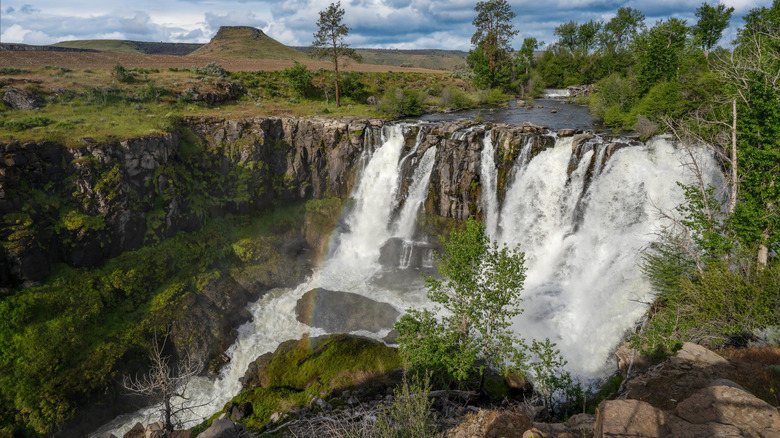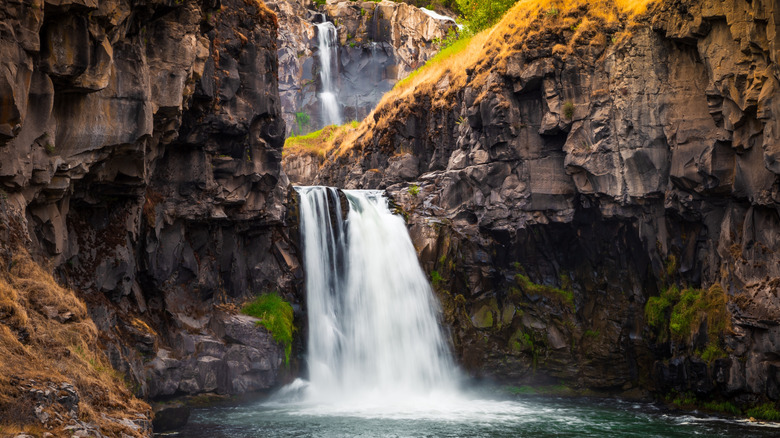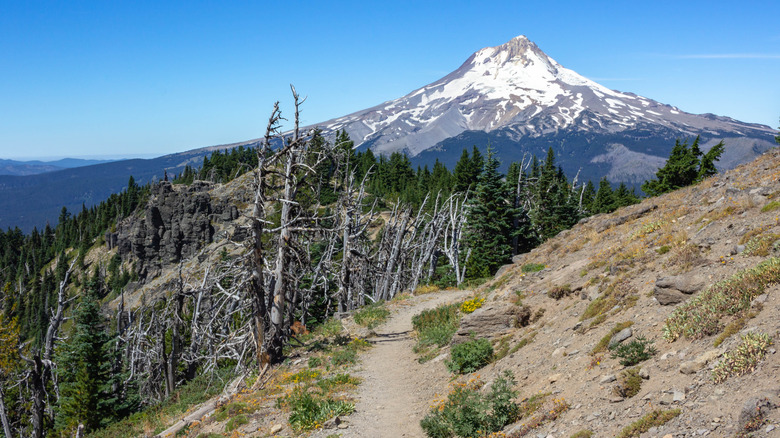The Under-The-Radar Canyon State Park Best Known As Oregon's 'mini-Niagara' Is Full Of Scenic Trails
Tumbling from the basalt cliffs concealed in Oregon's wild center, the White River falls plunge into a rushing valley river. Found within the eponymous state park, the cascades can be accessed on a scenic hiking trail, rising through a historic canyon in the sweeping Tygh Valley. The 90-foot falls are best caught in the spring, when they tumble in full force and earn their nickname as Oregon's "mini-Niagara."
The state park is tucked away in the forests found just to the east of Oregon's Tygh Valley, along Highway 216. It's easy to reach the head of the trail that tracks out towards the cascades from well-connected Portland — in roughly two hours you can escape Portland crowds in the nearby, wildly underrated Oregon highlight. If you prefer to skip the city rush altogether, you can base your stay in the small town of Tygh Valley instead. Frequented by the frontiersmen that once tackled the river, it can be incorporated into an action-packed itinerary, exploring the mountains and forests to follow in pioneer footsteps and witness Oregon scenery on a historic western road trip. The Mt. Hood National Forest sits right in between Portland and the White River Falls State Park, so you'll have no shortage of outdoors adventure opportunities in this scenic region.
How to reach Oregon's White River falls
Hidden away from the highway by a scenic trekking trail, one of the best-kept secrets in Oregon is an enchanting hike to an impressive waterfall. To find the route leading out to the secluded falls, make your way to White River Falls State Park. The trail is easy to follow — park up and set out on foot on the 0.7-mile hike down into the craggy canyon from which the falls cascade. Though it's a short trek, the trail is rocky and steep. It's a rugged route that leads out to a scenic viewing platform, where you can get a spectacular vantage over the tumbling waters.
Out-and-back, the trail takes less than half an hour to complete, but you should take your time enjoying the waterfall views. As you walk into the craggy valley you can keep an eye out for native birds like Bullock's orioles and American dippers, ground squirrels scampering across the trail, and blushing wildflowers that bloom in the park's springtime peak. You'll be able to take in the views over the mesas of the Devils Halfacre as you descend, catching your first views of the canyon's historic power plant. Get a closer look by crossing the wooden pathway that leads towards the abandoned plant, one of Oregon's earliest hydroelectric power stations.
You can also tackle a scrambling onwards trail for a second cascade view — this optional add on will give you an up-close look at the Celestial Falls, the 45-foot lower tier of White River Falls. Stroll downstream through the sagebrush to rest by the water's edge, enjoying the fragrance of the desert parsley. It's inadvisable to swim here. The river currents are unpredictable and potentially highly dangerous.
More adventurous activities to enjoy in Oregon's Tygh Valley
Buried amid the lofty pines and Douglas-fir forests that swathe central Oregon, the White River falls are only one of the natural attractions that draw travelers to the westerly state. Crowned by the snow-slicked summit of Mt. Hood, wildlife filled woodlands and serene lakes can all be explored on a trip to the cascades.
Orient your itinerary around the vast Mt. Hood National Forest, a 1.1 million acre stretch of wilderness primed for exploration. Spanning southwards from the Columbia River Gorge, the protected region is an excellent option for hikers, mountain bikers, and campers looking to explore quiet forest trails. Add on another cascade vista and hike to the base of the Tamanawas Falls, following a 3.5-mile out-and-back trail that crosses dense forests and the mighty Hood River. Alternatively, take to two wheels and shred across the Sandy Ridge Trail System, where 17 miles of track offer thrilling routes for mountain bikers. You can extend your stay by setting up camp in one of the area's over 2,000 designated grounds.
Aligning with the falls' springtime prime, the snow sports season in Mt. Hood Meadows lasts until May. Here, skiers and snowboarder can still carve across fresh powder on the 12,240-foot-high dormant volcano. The mountain itself is also an extremely popular mountain climbing destination which attracts more than 10,000 adventurers annually, making it the second most climbed glaciated peak in the world.


